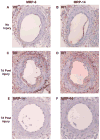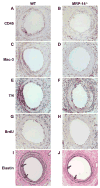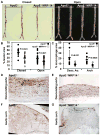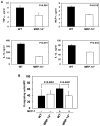Myeloid-related protein-8/14 is critical for the biological response to vascular injury
- PMID: 19620505
- PMCID: PMC3070397
- DOI: 10.1161/CIRCULATIONAHA.108.814582
Myeloid-related protein-8/14 is critical for the biological response to vascular injury
Abstract
Background: Myeloid-related protein (MRP)-8 (S100A8) and MRP-14 (S100A9) are members of the S100 family of calcium-modulated proteins that regulate myeloid cell function and control inflammation, in part, through activation of Toll-like receptor-4 and the receptor for advanced glycation end products. A transcriptional profiling approach in patients with acute coronary syndromes identified MRP-14 as a novel predictor of myocardial infarction. Further studies demonstrated that elevated plasma levels of MRP-8/14 heterodimer predict increased risk of first and recurrent cardiovascular events. Beyond its serving as a risk marker, whether MRP-8/14 participates directly in vascular inflammation and disease remains unclear.
Methods and results: We evaluated vascular inflammation in wild-type and MRP-14-deficient (MRP-14(-/-)) mice that lack MRP-8/14 complexes with experimental arterial injury, vasculitis, or atherosclerosis. After femoral artery wire injury, MRP-14(-/-) mice had significant reductions in leukocyte accumulation, cellular proliferation, and neointimal formation compared with wild-type mice. In a cytokine-induced local Shwartzman-like reaction that produces thrombohemorrhagic vasculitis, MRP-14(-/-) mice had significant reductions in neutrophil accumulation, lesion severity, and hemorrhagic area. In response to high-fat feeding, mice doubly deficient in apolipoprotein E and MRP-8/14 complexes had attenuation in atherosclerotic lesion area and in macrophage accumulation in plaques compared with mice deficient in apolipoprotein E alone.
Conclusions: This study demonstrates that MRP-8/14 broadly regulates vascular inflammation and contributes to the biological response to vascular injury by promoting leukocyte recruitment.
Conflict of interest statement
The authors report no significant conflicts of interest.
Figures








References
-
- Libby P. Inflammation in atherosclerosis. Nature. 2002;420(6917):868–874. - PubMed
-
- Hansson GK, Libby P, Schonbeck U, Yan ZQ. Innate and adaptive immunity in the pathogenesis of atherosclerosis. Circulation research. 2002;91(4):281–291. - PubMed
-
- Healy AM, Pickard MD, Pradhan AD, Wang Y, Chen Z, Croce K, Sakuma M, Shi C, Zago AC, Garasic J, Damokosh AI, Dowie TL, Poisson L, Lillie J, Libby P, Ridker PM, Simon DI. Platelet expression profiling and clinical validation of myeloid-related protein-14 as a novel determinant of cardiovascular events. Circulation. 2006;113(19):2278–2284. - PubMed
-
- Vogl T, Tenbrock K, Ludwig S, Leukert N, Ehrhardt C, van Zoelen MA, Nacken W, Foell D, van der Poll T, Sorg C, Roth J. Mrp8 and Mrp14 are endogenous activators of Toll-like receptor 4, promoting lethal, endotoxin-induced shock. Nat Med. 2007;13(9):1042–1049. - PubMed
-
- Boyd JH, Kan B, Roberts H, Wang Y, Walley KR. S100A8 and S100A9 Mediate Endotoxin-Induced Cardiomyocyte Dysfunction via the Receptor for Advanced Glycation End Products. Circulation research. 2008 - PubMed
Publication types
MeSH terms
Substances
Grants and funding
LinkOut - more resources
Full Text Sources
Other Literature Sources
Medical
Molecular Biology Databases
Miscellaneous

